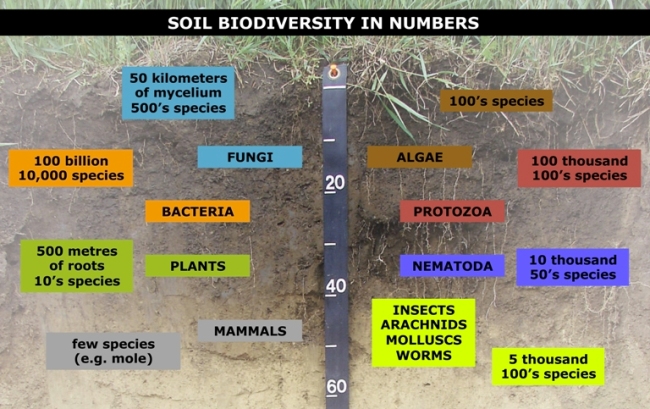Biodiversity interactions: Difference between revisions
No edit summary |
No edit summary |
||
| Line 5: | Line 5: | ||
Soil biodiversity includes the living organisms and their interactions with each other, along with plants in the soil. Soil life varies with environment, from the other side of the world, the country, or even a tree. For example, a handful of soil from one spot on the forest floor may contain a very different selection of life from soil two feet away. This is because of variations in the availability of water or nutrients. [3] This immense variety serves as a cause for the many interactions, effects, and services that this ecosystem creates and contributes to. The benefits gained from this ecological environment affect not only the sub-terrestrial, but the surrounding environment as well. | Soil biodiversity includes the living organisms and their interactions with each other, along with plants in the soil. Soil life varies with environment, from the other side of the world, the country, or even a tree. For example, a handful of soil from one spot on the forest floor may contain a very different selection of life from soil two feet away. This is because of variations in the availability of water or nutrients. [3] This immense variety serves as a cause for the many interactions, effects, and services that this ecosystem creates and contributes to. The benefits gained from this ecological environment affect not only the sub-terrestrial, but the surrounding environment as well. | ||
[[File:soil_biodiversity.jpg|right]] | [[File:soil_biodiversity.jpg|right]] | ||
==='''The Benefits'''=== | ==='''The Benefits'''=== | ||
Revision as of 13:27, 24 April 2018
Biodiversity Interactions
Soil is one of the most important natural resources for life on this planet and contributes to many ecological systems.
What is Soil Biodiversity?
Soil biodiversity includes the living organisms and their interactions with each other, along with plants in the soil. Soil life varies with environment, from the other side of the world, the country, or even a tree. For example, a handful of soil from one spot on the forest floor may contain a very different selection of life from soil two feet away. This is because of variations in the availability of water or nutrients. [3] This immense variety serves as a cause for the many interactions, effects, and services that this ecosystem creates and contributes to. The benefits gained from this ecological environment affect not only the sub-terrestrial, but the surrounding environment as well.

The Benefits
Soil is a vital part of the environment. Variability in substrate quality and soil habitat causes wide variation in soil microbial communities and functions of nutrient cycles in forest soils. [5] The diverse life in the soil processes waste organic matter in order to sustain terrestrial life, regulate the water cycle and the carbon flux, decontaminate the soil and air due to pollution, and essentially provide us with medicine. (antibiotics) [2]
Carbon Flux
- Through photosynthesis, plants draw carbon out of the air to form carbon compounds. The plant then exudes what it doesn't need for growth through its roots to supply soil organisms, where the carbon is then rendered stable, giving soil its structure, fertility, and water retention capabilities as well. [4]
- When plants and animals die, they are decomposed into the soil by the biota. The carbon then leaves their bodies and is sent back into the atmosphere. [4]
- The continual decaying of plant material and greater species diversity in soil maximizes carbon storage and its cycling process. [4] [6]
Soil Organic Matter
- The decomposition of this matter is a naturally occurring biological process that is determined by soil organisms, the physical environment and the quality of the organic matter.
- the products released during decomposition of organic matter include: carbon dioxide, energy, water, plant nutrients and resynthesized organic carbon compounds. [6]
- Soil organic matter is a food source for soil organisms and micro-organisms.
- the waste material from these organisms is mineralized into the soil and is used by plants for nutrients.
- By breaking down carbon and rebuilding new ones (by feeding off the organic matter and excreting it back into the soil), soil biota plays the most important role in nutrient cycling processes and can provide nutrients through soil to harvest healthy plants. [6]